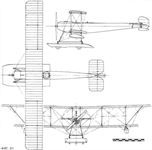
Описание
Страна: Великобритания
Год: 1913
Варианты
- Avro - 501 - 1913 - Великобритания
- Avro - 503/Type H - 1913 - Великобритания
- Gotha - WD.1/WD.2 - 1914 - Германия
- Gotha - WD.5/WD.9 - 1915 - Германия
- Gotha - WD.12/WD.13/WD.15 - 1917 - Германия
- A.Jackson Avro Aircraft since 1908 (Putnam)
- O.Thetford British Naval Aircraft since 1912 (Putnam)
- M.Goodall, A.Tagg British Aircraft before the Great War (Schiffer)
- P.Lewis British Aircraft 1809-1914 (Putnam)
-
M.Goodall, A.Tagg - British Aircraft before the Great War /Schiffer/
The Avro Type 501.
-
M.Goodall, A.Tagg - British Aircraft before the Great War /Schiffer/
The Avro 501 in landplane form with naval serial 16 at Eastchurch 1913.
-
A.Jackson - Avro Aircraft since 1908 /Putnam/
The Avro 501 in landplane form with naval serial 16 at Eastchurch 1913.
The converted Avro 503 with wheel undercarriage, strut-braced extensions on the upper wings, and enlarged ailerons.
A.Jackson Avro Aircraft since 1908 (Putnam)
Avro 501 and Avro 503 (Type H)
The choice of Shoreham as the Avro company’s new flying ground when it moved from Brooklands in the autumn of 1912 was largely the result of Cdr Schwann’s successful waterborne experiments and Avro’s awakening interest in seaplanes. It was an ideal site with Shoreham Harbour close at hand and it was from the adjacent River Adur that the Avro Type H seaplane made its first take-off. Construction of this machine followed tests on Windermere by H. Stanley Adams in January 1913 with the Avro 501 which, apart from a considerable strut-braced top wing overhang, was similar to an enlarged float-equipped Avro 500. Built at Brownsfield Mills in November 1912 and powered by a 100 hp Gnome, the Avro 501 first flew as an amphibian with a sprung central float designed by O. T. Gnosspelius, 15 ft long and 7 ft wide from which projected three small wheels, two in the rear and one forward. With so narrow a float an aircraft with a wing span of 47 ft 6 ins could be expected to heel over when steerage way was lost, and for this reason small wing tip floats were fitted and inclined to sit squarely in the water. This arrangement proved unsatisfactory and Gnosspelius replaced it with a twin float unit without wheels which made the aircraft sufficiently seaworthy to interest the Admiralty, to whom it was eventually delivered in the Isle of Grain. In the light of experience at Barrow, the airscrew leading edges were sheathed with brass to prevent damage from flying spray and the tail float was bolted directly to the old-style sprung rudder for steering on the water.
<...>
The float undercarriage of the old Avro 501 having proved far too heavy, the Admiralty agreed to accept it as a landplane. A. V. Roe thereupon devised a two-wheel, twin-skid undercarriage but the track was still too narrow to support the aircraft vertically at rest and stout wing tip skids were necessary. In land-plane form, with large inversely tapered ailerons replacing the constant chord units, the Avro 501 was so quaint a structure that it soon earned the name ‘Rickety Ann’. After delivery to Eastchurch it had to be lightened and several airscrews tried before F. P. Raynham could complete the acceptance tests. Bearing naval serial 16 it was flown to Shoreham on June 2, 1913, by Raynham with Lt Seddon as passenger.
<...>
SPECIFICATION AND DATA
Manufacturers: A. V. Roe and Company (reconstituted as A. V. Roe, and Co. Ltd. 11.1.13), Brownsfield Mills, Great Ancoats Street, Manchester (moved to Clifton Street, Miles Platting, Manchester 4.13); and Shoreham Aerodrome, Sussex
Power Plant: One 100 h.p. Gnome
Dimensions, Weights and Performances:
Avro 501 seaplane
Span (upper) 47ft. 6 in.
Span (lower) 39ft. 6 in.
Length 33ft. 0 in.
Height 12ft. 6 in.
Wing area 478 sq. ft.
Tare weight 1,740 lb.
All-up weight 2,700 lb.
Maximum speed 55 m.p.h.*
*Landplane 65 m.p.h.
Production:
Avro 501 seaplane, first flown on Windermere 1.13, converted to landplane serial 16, still airworthy in 1914
Описание:




